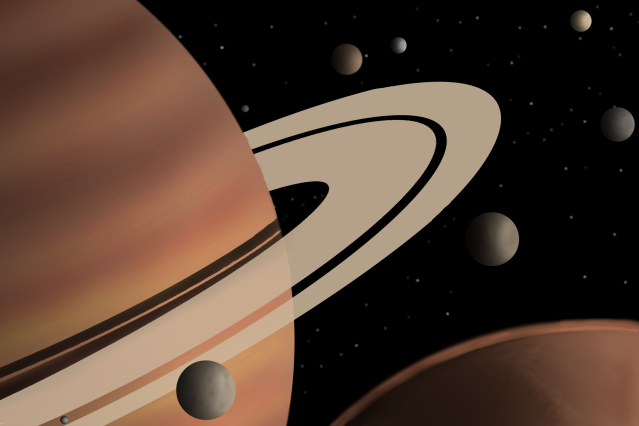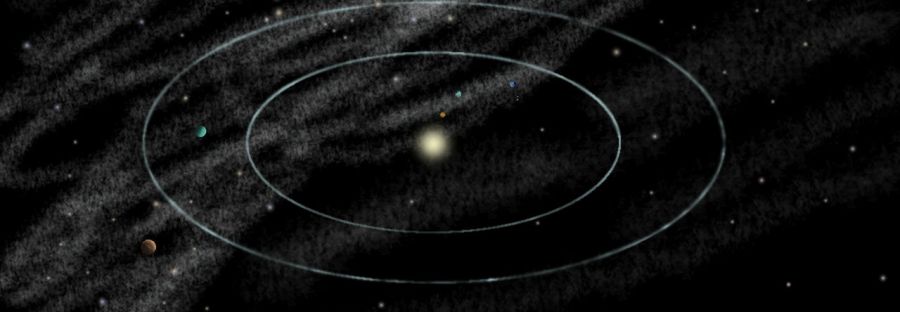This represents a *semi-scaled model of the Anidril Solar System, as viewable to-date from its habitable planets. The orange-ringed yellow circle represents Anidril (the proper name of the Star Areaer shares as its sun with several other planets). I wish to note here that while I have chosen a mostly modern depiction of the universe at large, as opposed to an ancient and medieval one, and am here providing details about it, my series are true High Fantasy, and not science fiction. There is no scientific or seudo-scientific justification for the magic or many of the odder things that appear in the world; the magic has its own “laws” and “nature” which have nothing to do with the modern conception of the world lent by science, and so far no technological marvels (though there are plenty of magical ones), but just as High Fantasy can be set in a Medieval conception of the world as flat and orbited by the sun, so it can be set in a more modern conception of galaxies and planets, and this I have done with Areaer and the rest of its universe, since I happened to find some such things to be cool and to lend an interesting aesthetic and perspective to my fantasy at the time I first conceived of Areaer, and I believe that such things can be incorporated into and become part of the magic of a universe, just as elm trees and oaks have been part of the magic of High Fantasy for centuries. You can read any of the series without these facts about the design of the universe at large becoming a big deal if you don’t want to think about them, and some of the novels without discovering more than that Areaer is round, if that much, and, as in High Fantasy set in a more Medieval or otherwise ancient conception of the earth, all sorts of things can be and are preserved or altered through magic, so many aspects of the more modern conception of the universe are here enhanced or altered and imbued with magic.
I have placed the information about each orbit in the same color text as the color in which the orbit is drawn.
Anidril is a bright yellow star with mass very similar to our sun, and, perhaps, just a little warmer. The sun-weather tends to be fairly active, with an abundance of sun-spots and prominences, and the star rarely goes into cooling phases.
 Anjea is a small, rocky planet with a scant atmosphere and one tiny moon. Its orbital period is approximately 219 days. Several cultures on Areaer and Alaer associate this faint morning and evening star with death and with the spirit world.
Anjea is a small, rocky planet with a scant atmosphere and one tiny moon. Its orbital period is approximately 219 days. Several cultures on Areaer and Alaer associate this faint morning and evening star with death and with the spirit world.
 Areaer is the planet second from the sun. It is nearly the same size, density and composition as our earth, and supports a great variety of life. It orbits Anidril in approximately 359 days, 11 **hours, and 54 minutes, measured as on earth. Its days are a few minutes shorter than ours on earth, so it orbits its Sun in just under 360 of its own days. It has one moon very like our own, which orbits it almost exactly once every 29 Areaeran days, and one small far-out moon. Explore Areaer in more depth here.
Areaer is the planet second from the sun. It is nearly the same size, density and composition as our earth, and supports a great variety of life. It orbits Anidril in approximately 359 days, 11 **hours, and 54 minutes, measured as on earth. Its days are a few minutes shorter than ours on earth, so it orbits its Sun in just under 360 of its own days. It has one moon very like our own, which orbits it almost exactly once every 29 Areaeran days, and one small far-out moon. Explore Areaer in more depth here.
 Alaer is third from the sun. It is a rather cool world, about the size of earth or Areaer, and it is almost completely covered in oceans that team with life. Its orbital period is about 686 days, as measured on earth, but it rotates on its own axis in just about 21 hours, meaning that, in its own days, an Alaeran year is just over 784 days. It has a reasonably-sized moon which orbits it about once every 25 Alaeran days. Explore Alaer in more depth here.
Alaer is third from the sun. It is a rather cool world, about the size of earth or Areaer, and it is almost completely covered in oceans that team with life. Its orbital period is about 686 days, as measured on earth, but it rotates on its own axis in just about 21 hours, meaning that, in its own days, an Alaeran year is just over 784 days. It has a reasonably-sized moon which orbits it about once every 25 Alaeran days. Explore Alaer in more depth here.
 Next out from Anidril is a very thick Asteroid Belt or very thin Ring. From Areaer it is a very slight feature, noticed less than the planet’s second, smaller moon, but from Alaer it is quite distinguishable.
Next out from Anidril is a very thick Asteroid Belt or very thin Ring. From Areaer it is a very slight feature, noticed less than the planet’s second, smaller moon, but from Alaer it is quite distinguishable.
The Outer Anidril System
 Beyond Anidril’s first Asteroid Belt lies Arxeal, a small banded blue-green gas giant, no more massive than about twelve earths, orbiting Anidril in about 11 and a half years. It possesses a handful of rings, some fainter than others. It has six primary moons; a rayed, cracked, and cratered icy moon in a large gap between the two outer most rings, on the outer edge of the outermost ring a small, dense, rocky moon; next out a quite large moon with a great deal of terrain; after that an even larger moon with a faint atmosphere and some volcanic craters, and last and farthest out a very large, gleaming icy moon, with a small rocky moon following it along its orbit.
Beyond Anidril’s first Asteroid Belt lies Arxeal, a small banded blue-green gas giant, no more massive than about twelve earths, orbiting Anidril in about 11 and a half years. It possesses a handful of rings, some fainter than others. It has six primary moons; a rayed, cracked, and cratered icy moon in a large gap between the two outer most rings, on the outer edge of the outermost ring a small, dense, rocky moon; next out a quite large moon with a great deal of terrain; after that an even larger moon with a faint atmosphere and some volcanic craters, and last and farthest out a very large, gleaming icy moon, with a small rocky moon following it along its orbit.
 Next out is another Asteriod Belt, this one thinner and far wider.
Next out is another Asteriod Belt, this one thinner and far wider.
 Even beyond that is Aldexae, a yellowish gas giant nearly two and a half times the mass of Jupiter, orbiting Anidril approximately once every 150 years. It boasts a massive array of moons, including two huge and relatively far out tectonically active moons orbiting each other as they orbit the planet, one nearly a third the mass of Earth, the other about the size of Mars. It has three large moons with atmospheres of some sort, one of them much smaller than the other two, and a good handful of icy or rocky moons of various sizes, a few of them quite tiny. It also has two massive ring systems.
Even beyond that is Aldexae, a yellowish gas giant nearly two and a half times the mass of Jupiter, orbiting Anidril approximately once every 150 years. It boasts a massive array of moons, including two huge and relatively far out tectonically active moons orbiting each other as they orbit the planet, one nearly a third the mass of Earth, the other about the size of Mars. It has three large moons with atmospheres of some sort, one of them much smaller than the other two, and a good handful of icy or rocky moons of various sizes, a few of them quite tiny. It also has two massive ring systems.
*The distances between the orbits of the planets and belt are approximately correct.
**Hours and minutes always correspond to the measurement used on earth in this post (though not in the actual novels – though the difference on Areaer is so slight most people would need an hourglass or a watch to notice it). Years, however, are given both in days as they would be reckoned on earth and in the number of rotations the planet in question completes upon its own axis in the time-period in which it circles Anidril once, when this number is known and more or less corresponds to what we would experience as a ‘day’.
Solar system designed by Raina Nightingale. Gallery images by James Geary. All other images or art by Raina Nightingale.
















